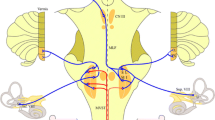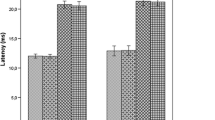Abstract
This study applied both ocular vestibular-evoked myogenic potential (oVEMP) and cervical VEMP (cVEMP) tests in patients with cerebellar disorders to determine whether VEMP test can differentiate between cerebellar and brainstem lesions. A total of 12 patients with cerebellar disorder, including extended cerebellar lesion (involving the brainstem) in 8 and localized cerebellar lesion (excluding the brainstem) in 4, were enrolled in this study. All patients underwent caloric, visual suppression, and oVEMP and cVEMP tests via bone-conducted vibration stimuli. The abnormal rates for the caloric, visual suppression, and oVEMP and cVEMP tests were 62, 83, 88 and 75% in patients with extended cerebellar lesion and 0, 25, 0 and 0% in those with localized cerebellar lesion, respectively. The rate of abnormal oVEMP results significantly differed between the two groups, but caloric, visual suppression and cVEMP test results did not differ. In another ten healthy subjects, characteristic parameters of oVEMPs obtained under light and dark conditions did not significantly differ. In conclusion, ocular VEMP test can differentiate between cerebellar and brainstem lesions. Abnormal oVEMPs in patients with cerebellar disorder may indicate adjacent brainstem involvement.



Similar content being viewed by others
References
Stahle J (1990) Controversies on the caloric response. From Bárány’s theory to studies in microgravity. Acta Otolaryngol 109:162–167
Robinson DA (1976) Adaptive gain control of vestibulo-ocular reflex by the cerebellum. J Neurophysiol 39:954–961
Takemori S, Cohen B (1974) Loss of visual suppression of vestibular nystagmus after flocculus lesions. Brain Res 72:213–224
Vibert ND, Waele C, Escudero M, Vidal PP (1993) The horizontal vestibulo-ocular reflex in the hemilabyrinthectomized guinea-pig. Exp Brain Res 97:263–273
Baloh RW, Jenkins HA, Honrubia V, Yee RD, Lau CJY (1979) Visual–vestibular interaction and cerebellar atrophy. Neurology 29:116–119
Sharpe JA, Goldberg HJ, Lo AW, Herishanu YO (1981) Visual–vestibular interaction in multiple sclerosis. Neurology 31:427–443
Curthoys IS (2010) A critical review of the neurophysiological evidence underlying clinical vestibular testing using sound, vibration and galvanic stimuli. Clin Neurophysiol 121:132–144
Iwasaki S, Smulders YE, Burgess AM, McGarvie LA, Macdougall HG, Halmagyi GM, Curthoys IS (2008) Ocular vestibular evoked myogenic potentials in response to bone conducted vibration of the midline forehead at Fz. Audiol Neurotol 13:396–404
Rosengren SM, Welgampola MS, Colebatch JG (2010) Vestibular evoked myogenic potentials: past, present and future. Clin Neurophysiol 121:636–651
Tseng CL, Young YH (2010) Topographical correlations of lateral medullary infarction with caloric and vestibular evoked myogenic potential results. Eur Arch Otorhinolaryngol 267:191–195
Young YH (2006) Vestibular evoked myogenic potentials: optimal stimulation and clinical application. J Biomed Sci 13:745–751
Cheng PW, Chen CC, Wang SJ, Young YH (2009) Acoustic, mechanical and galvanic stimulation modes elicit ocular vestibular-evoked myogenic potentials. Clin Neurophysiol 120:1841–1844
Chang CH, Yang TL, Wang CT, Young YH (2007) Measuring neck structures in relation to vestibular evoked myogenic potentials. Clin Neurophysiol 118:1105–1109
Wang SJ, Weng WJ, Jaw FS, Young YH (2010) Ocular and cervical vestibular evoked myogenic potentials: a study to determine whether bone conducted vibration or air conducted sound to optimize response. Ear Hear 31:283–288
McCrea RA, Strassman A, May E, Highstein SM (1987) Anatomical and physiological characteristics of vestibular neurons mediating the horizontal vestibulo-ocular reflex of the squirrel monkey. J Comp Neurol 264:547–570
Takemori S, Aiba T, Shizawa R (1981) Visual suppression of caloric nystagmus in brain-stem lesions. Ann NY Acad Sci 374:846–854
Suzuki JI, Tokumasu K, Goto K (1969) Eye movements from single utricular nerve stimulation in the cat. Acta Otolaryngol 68:350–362
Gianna CC, Gresty MA, Bronstein AM (2000) The human linear vestibulo-ocular reflex to transient accelerations: visual modulation of suppression and enhancement. J Vestib Res 10:227–238
Young YH, Chuu JJ, Liu SH, Lin-Shiau SY (2001) Toxic effects of potassium bromate and thioglycolate on vestibuloocular reflex system of guinea pigs and humans. Toxicol Appl Pharmacol 177:103–111
Young YH, Chuu JJ, Liu SH, Lin-Shiau SY (2002) Neurotoxic mechanism of cinnabar and mercuric sulfide on vestibulo-ocular reflex system of guinea pigs. Toxicol Sci 67:256–263
Acknowledgments
We acknowledge Grant no. NSC 99-2314-B002-049-MY3 from the National Science Council, Taipei, Taiwan.
Conflict of interest
The authors declare that they have no conflict of interest.
Author information
Authors and Affiliations
Corresponding author
Rights and permissions
About this article
Cite this article
Su, CH., Young, YH. Differentiating cerebellar and brainstem lesions with ocular vestibular-evoked myogenic potential test. Eur Arch Otorhinolaryngol 268, 923–930 (2011). https://doi.org/10.1007/s00405-010-1463-0
Received:
Accepted:
Published:
Issue Date:
DOI: https://doi.org/10.1007/s00405-010-1463-0




